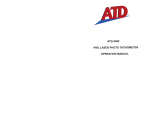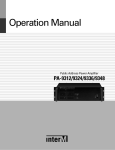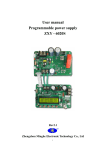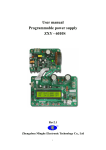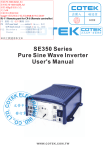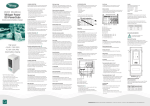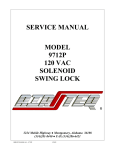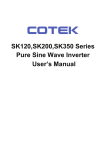Download 1397-IN011 - Rockwell Automation
Transcript
Instructions Allen-Bradley 1397 AC Tachometer Interface Card Cat. No. 1397-AC Contents Topic What This Option Provides Where This Option Is Used What These Instructions Contain Specifications How to Select an AC Tachometer Installation Tachometer Wiring Setup Page 1 1 1 1 2 3 6 6 What this Option Provides The AC Tachometer Interface Card is designed for use with the following Reliance tachometers RE-045F, RE-045R or RE-050. The card provides feedback signals for non-regenerative 1397 drives and cannot be used in conjunction with the Pulse Encoder Interface Card. Where this Option is Used This option may only be used with 1397 Non-Regenerative Drives. What These Instructions Contain These instructions contain the necessary information to install & configure a 1397 AC Tachometer Interface Card. For additional information on signal requirements, wire or cable requirements and parameter programming, refer to the 1397 User Manual, publication 1397-5.0 and the AC tachometer instructions. Specifications Item Maximum Cable Length: Maximum Power Dissipation: Maximum Input Voltage from Tachometer: Input Impedance: Specification Refer to the AC Tachometer Instructions 4W 275V AC rms 20k Ohms 2 Allen-Bradley 1397 AC Tachometer Interface Card How to Select an AC Tachometer Before installing the AC Tachometer Interface Card, the tachometer’s maximum AC output voltage and the card’s maximum DC output voltage must be calculated. Performing these calculations will assure: • That the correct AC tachometer is selected. • That the correct drive Regulator Board settings are made. • That the Tachometer Interface Card is wired correctly. Step 1 – Determine the Tachometer’s Maximum AC Output Voltage As listed in the card’s specifications; at the application’s maximum motor RPM, voltage at the input of the AC Tachometer Interface Card must not exceed 275V AC rms. VAC in = [Tach volt x N max] 1000 where: VAC in = The Interface Card’s Maximum AC Input Voltage. Tach volt = P.047 [Anlg Tach V/1000]. The Tachometer’s Nameplate Volts/1000 RPM Rating. N max = Required Maximum Motor RPM for the Application. Step 2 – Determine the Card’s Maximum DC Output Voltage VDC out = VAC in x 0.9 where: VDC out = The Interface Card’s Maximum DC Output Voltage. VAC in = The Interface Card’s Maximum AC Input Voltage Example An RE-045F Reliance Tachometer is used in an application that has a required maximum motor speed of 2500 RPM. An RE-045F Tachometer has a nameplate output voltage of 45V AC (+10V AC/–5V AC) / 1000. Determine the Card’s Maximum AC Input Voltage VAC in = [(45 + 10) x 2500] 1000 VAC in = 137.5V AC Determine the Card’s Maximum DC Output Voltage VDC out = 137.5V AC x 0.9 VDC out = 123.75V DC Allen-Bradley 1397 AC Tachometer Interface Card Installation ATTENTION: This board contains ESD (Electrostatic Discharge) sensitive parts and assemblies. Static control precautions are required when installing, testing, servicing or repairing this assembly. Component damage may result if ESD control precautions are not followed. If you are not familiar with static control procedures, reference publication 8000-4.5.2, “Guarding against Electrostatic Damage” or any other applicable ESD protection handbook. ! ATTENTION: Electric Shock can cause injury or death. Remove all power before working on this product. The drive is at line voltage when connected to incoming AC power. Before proceeding with any installation or troubleshooting activity, disconnect, lock out, and tag all incoming power to the drive. Verify with a voltmeter that no voltage exists at terminals L1, L2 and L3 on the drive input power terminal block. ! 1. Remove and lock-out all incoming power to the drive. Loosen the (2) captive retaining screws and remove the drive cover. Captive Thumb Screw Captive Thumb Screw 2. Loosen the captive carrier retaining screw and swing the carrier door open. Captive Carrier Screw J28 3 4 Allen-Bradley 1397 AC Tachometer Interface Card 3. To remove the carrier shield, remove the (4) retaining screws and unplug the ground wire at the Power Supply Board. Retaining Screw Retaining Screw Carrier Shield Retaining Screw Retaining Screw Carrier Shield Connector J17 Power Supply Board J17 Allen-Bradley 1397 AC Tachometer Interface Card If an I/O Expansion Card is also required, complete both Steps 4 and 5. 4. Install the AC Tachometer Interface Card in the drive carrier using the (2) pan head screws provided. J17 77 78 AC Tachometer Interface Card J1 BLACK ORANGE 77 78 77 78 J2 J1 +VDC COM 77 78 Pan Head Screw Pan Head Screw 5. If an I/O Expansion Card is used, the AC Tachometer Interface Card is mounted piggy back on the I/O Expansion Board and connected using the hardware included with the AC Tachometer Interface Kit. 68 69 68 69 J17 J10 I/O Expansion Card J1 J2 AC Tachometer Interface Card 77 78 INT EXT J15 MA BLACK ORANGE 77 78 +VDC COM J12 J1 77 78 J2 V J14 IOUT SOURCE J11 ANALOG OUTPUT 1 J1 77 78 PARK V MA VOLTS J5 (ANALOG J7 J6 INPUT) 14-20 J8 J9 38 39 40 41 42 43 44 50 51 52 53 54 55 56 57 58 59 60 61 62 63 64 65 66 67 68 69 Pan Head Screw 38 39 40 41 42 43 44 50 51 52 53 54 55 56 57 58 59 60 61 62 63 64 65 66 67 68 69 Pan Head Screw 6. Connect the AC output tachometer leads to AC terminals 77 & 78 – Polarity is unimportant. 5 6 Allen-Bradley 1397 AC Tachometer Interface Card 7. Route the card’s orange and black twisted cable underneath the drive carrier to Regulator Board Terminal Block J3 as shown. Make connections to J3 per the table on page 7. Terminal Block J3 Tachometer Wiring Refer to the Cable & Wire Recommendations in the 1397 User Manual as well as any tachometer wiring instructions included with the Reliance tachometer. ATTENTION: Applying the incorrect polarity to the AC Tachometer Interface Card’s orange & black J2 output wires can cause an overspeed condition. Connect these wires accurately as described in the Setup Section that follows. Failure to observe this precaution could result in bodily injury and/or equipment damage. ! Setup (4) parameters as well as Jumpers J11 & J14 on the drive’s Regulator Board are used to configure the AC Tachometer Interface Card. J6 A FB RM RB 1 J18 J AR 17 M1 GR J2 OU 2 ND J25 S LO T LD C E FIE ET D LY P P U S S ER -C P LD M B U FIE J -C LE E A B A M BL N IM A A E LE O G R EN LE B O B A R A IS P IS D R D TO ED E LA T U E P N G P S E E Y R R T R U C J20 J15 J16 J21 J27 J24 J23 80 AB 3624 139 -09 7 3A J26 J1 Jumper J14 E X T J19 R E F I/O Terminal Block J3 J3 23 2 4 J12 TO 0 -5 H) 10 OT RK (B PA 20 21 2 2 J10 S F LT PS E S R LT VO AM TO O M U V 4A 20 18 1 9 U A J14 V ax H C GE HI 0 m TA AN 25 R ax LO 2 m 6 V H C LE TA CA S J11 16 1 7 50 /2 25 62 /1 31 16 6 7 8 9 J2 10 11 1 2 13 14 1 5 T O P L A U N A EF M R 1 2 3 4 5 J7 Jumper J11 J28 J5 25 26 2 7 28 J4 29 30 31 3 2 Allen-Bradley 1397 AC Tachometer Interface Card Wire & Jumper Settings Wire & jumper settings are made to the drive’s Regulator Board based on the DC output voltage calculated in Step 2 on page 2. Set Jumper J11 to — ≤ 16V DC 16 Set Jumper J14 to — LO 62 Connect the Card's Twisted Cable to TB J3 Connect the Black Wire to Term 23 Connect the Orange Wire to — Term. 22 Lo C wR om a m ng on e If the Card's Calculated DC Output Voltage Is — 21 2 2 23 24 2 5 LO 62 LO 62 Term. 22 21 2 2 23 LO 62 25 /1 31 32-62V DC Lo C wR om a m ng on e 31/125 62/250 LO 62 Term. 22 21 2 2 23 24 2 52 6 27 28 2 9 30 Lo C wR om a m ng on e 16 17-31V DC 24 2 5 I H 0 25 25 /1 31 on m om h R an ge Term. 21 on ig m om HI 250 24 2 52 6 27 28 2 9 30 H 62/250 an R h ig 21 2 2 23 21 2 2 23 24 2 5 C 126-250V DC ge Term. 21 26 2 7 28 29 3 0 C HI 250 H 31/125 LO 62 50 /2 62 63-125V DC 26 2 7 28 29 3 0 I H 0 25 50 /2 62 26 2 7 28 29 3 0 7 8 Allen-Bradley 1397 AC Tachometer Interface Card AC Tachometer Parameter Settings To finish configuring the card for the selected AC Tachometer, up to (4) parameters must be set depending upon the application. When setting AC tachometer parameters, P.194 [Anlg Tach Fdbk] may be used to “zero” the tachometer as indicated. ! ATTENTION: The incorrect setting of parameters P.039, P.047, P.057 and P.058 can cause an overspeed condition. Both parameters must be set by a qualified person who understands the significance of setting them. Set the value of these parameters accurately per your application requirements. Failure to observe this precaution could result in bodily injury. P.039 – Set Feedback Type to AC Tach This parameter is set to match the type of drive feedback signal used. Default Value = Arm Volt P.047 – Set Anlg Tach V/1000 to the AC Tachometer’s Nameplate Voltage/1000. The Same Value Set in Step 1 on Page 2 This parameter along with P.041 is used by the drive to calculate the value of the tachometer’s range. Default Value = 18.0 volts/1000 P.057 – Reset Anlg Tach Gain Only if Required This is an advanced setup parameter used to scale the AC tachometer feedback signal only after all AC tachometer installation is complete and then only if required. Refer to the Start-Up and Adjustment procedures in the 1397 User Manual as well as any tachometer instructions included with the Reliance tachometer kit for additional information. Default Value = 0 P.058 – Reset Anlg Tach Zero Only if Required This is an advanced setup parameter used to remove any hardware induced offset from the AC tachometer feedback loop signal. If the value of P.194 [Anlg Tach Fdbk] is some value other than zero, P.194 is “zeroed” using a corrective + or – P.058 value. Default Value = 1.000 Publication 1397-5.22 Ð December, 2001 Supersedes March, 1997 Copyright © 2001 Rockwell Automation. All rights reserved. Printed in USA.









